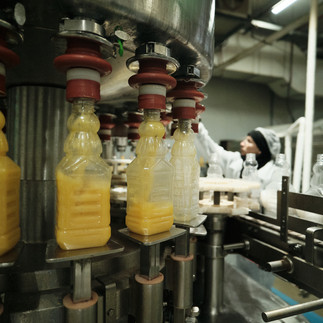Exclusives
How food-tech innovation is tackling sugar reduction and consumer safety concerns

Rafaela Sousa
5 November 2025
5 November 2025
How food-tech innovation is tackling sugar reduction and consumer safety concerns

As global debates around health and transparency reshape the food industry, sugar reduction is becoming one of its most complex frontiers. From consumer mistrust of additives to regulatory pressure on sugar content, brands are navigating a delicate balance between safety, taste and simplicity. Michael Gordon, CEO of BlueTree Technologies, explores how clean-label innovation and physical sugar removal technologies could redefine what 'better-for-you' means in 2025 and beyond.

Food safety and sugar consumption are increasingly intertwined in the minds of consumers. In 2025, food additives and ingredients became a top concern for American consumers, rising from 30% to 36% in just one year, according to the International Food & Health Council. At the same time, confidence in the US food supply fell to its lowest point in nearly a decade, with only 11% of Americans saying they are 'very confident' in its safety.
Global pressure to address sugar overconsumption adds another layer of urgency. The World Health Organization recommends limiting free sugars, such as those in fruit juices and concentrates, to less than 10% of daily caloric intake, citing links to obesity, diabetes and other health risks.
Both reports indicate the need for the food industry to deliver healthier, cleaner products without compromising taste or consumer confidence. The question remains: Is it possible for brands to create high-quality, reduced-sugar, additive-free products that maintain taste and consumer trust?
The additive dilemma
Consumers today are often confused and skeptical about sugar substitutes. For decades, artificial sweeteners like aspartame, sucralose or sorbitol have offered simple and effective ways to reduce sugar. However, those solutions now clash with modern expectations for “clean label” products. They are linked to potential health concerns, lack transparency and have long or unfamiliar ingredient lists, reinforcing the idea that reformulated foods are 'engineered'.
Skepticism extends beyond the ingredients themselves. Research shows a widespread lack of confidence in the regulatory frameworks meant to validate them.
Nearly half of UK adults surveyed reported low awareness of how artificial sweeteners are regulated, and although 72% said they generally 'trust regulatory bodies,' that belief didn’t predict how safe or beneficial they judged the sweeteners to be.
In the US, confidence in the food supply is also declining. Only 55% of Americans reported feeling 'very' or 'somewhat' confident in food quality assurance in 2025, down from 70% in 2023. Even with FDA regulations in place, consumers aren’t necessarily reassured.
So why develop a new sugar substitute if shoppers question who approves it? Consumers want less sugar, but they are not necessarily asking for fewer additives. They are looking for products with integrity: simple and transparent.
Faced with uncertainty, many reject the products that include these substances and the systems meant to validate them, resulting in the destruction of brands’ default paths to trust.
Consumers want both less sugar and fewer additives
Consumers are more health-conscious and label-savvy than ever. Yet for most, ingredient lists are filled with unfamiliar terms, leaving them to rely on simple rules of thumb when making decisions. One common benchmark is the five-ingredient rule, if a product has more than five ingredients, consumers may perceive it as overly processed or less trustworthy.
Sugar, however, remains one of the toughest challenges. It is not just a sweetener; it contributes to flavour balance, texture and shelf life. Reducing or removing it without affecting the sensory profile is a complex task.
Emerging food-tech solutions
Start-ups and research labs are developing strategies to reduce sugar without controversial non-natural ingredients. Using biotechnology, fermentation and plant-based chemistry, these approaches preserve taste and functionality while meeting consumer expectations for natural and transparent ingredients.
Fermentation-derived sweeteners: Precision fermentation enables the production of rare sugars, such as allulose and tagatose, that mimic sugar’s taste with fewer calories.
Plant-based alternatives: Advances in processing reduce bitterness and aftertaste in natural sweeteners such as stevia and monk fruit.
Enzyme-enabled sugar reduction: Enzymes can break down sugars in juices or dairy products, lowering their content without introducing new ingredients.
While each method represents progress, none is without limitations. Scaling fermentation is challenging, and regulatory classifications can lead to confusion over whether ingredients are considered “natural”.
Plant-based alternatives show promise, but acceptance varies by product category. Enzyme-driven solutions can be technically effective but may introduce formulation complexities that conflict with clean-label goals.
The case for physical sugar removal
Several approaches to sugar reduction represent important progress, but they often involve trade-offs in cost, taste, consumer perception, or scalability. Physical sugar removal methods offer an alternative. These processes selectively take out sugar rather than substituting or chemically altering it, and they are scalable.
Unlike additive-based methods, physical removal reduces sugar without introducing new ingredients, which helps maintain taste and texture. With 36% of consumers reporting concern about additives, this 'nothing added; approach may also address consumer preferences while aligning with World Health Organization guidance on sugar reduction.
Food safety in the spotlight
The focus on additive removal brings attention to reality. Food safety is about more than avoiding contamination. It is about building credibility in ingredients, processing methods, and the messages brands communicate.
Even when regulators deem artificial sweeteners harmless, public skepticism toward those judgments is growing. In the eyes of consumers, perception of risk can matter as much as the science.
Excess sugar also poses long-term health risks, prompting governments worldwide to implement sugar taxes, stricter labeling, and reformulation targets. Clean-label sugar reduction technologies address these demands, positioning companies to meet shifting regulatory and consumer expectations.
Challenges ahead
Clean-label sugar reduction is not without hurdles. Labeling and regulation add further complexity; even chemically identical ingredients may not legally be labeled as 'natural'.
Regulators are doing their part, but the greater challenge lies with the industry. Consumers are looking for products with real integrity, food that feels close to its source. Preserving that integrity requires investment in advanced equipment and solutions to manage the shorter shelf life of fresher, higher-quality products.
Beyond production and logistics, brands must also earn consumer trust. While regulators may declare a product safe, consumers look for clearer signals of quality and transparency. Programs that provide positive scores or 'green light' labels could help, but ultimately, it is the brands, not the regulators, that carry the responsibility for earning and sustaining confidence.
A convergence of health, trust and innovation
As consumers question not only ingredients but also the regulators who approve them, while health authorities call for reduced sugar, it is clear that simply swapping one ingredient for another is no longer enough.
Emerging physical removal technologies suggest a way to bridge the gap, cutting sugar while maintaining clean labels and consumer trust. Scalable and effective, this approach sets a new benchmark for food and beverage companies seeking innovations that satisfy both health goals and public perception.
Clean-label sugar reduction is more than a technical challenge; it is a test of how the food industry adapts to an era where consumer expectations, regulatory pressure, and health priorities converge. Done right, foodtech can move the industry beyond compromise, delivering healthier, simpler and sweeter products while rebuilding the consumer confidence that modern food safety demands.
Related news
Exclusives
How food-tech innovation is tackling sugar reduction and consumer safety concerns

Rafaela Sousa
5 November 2025






